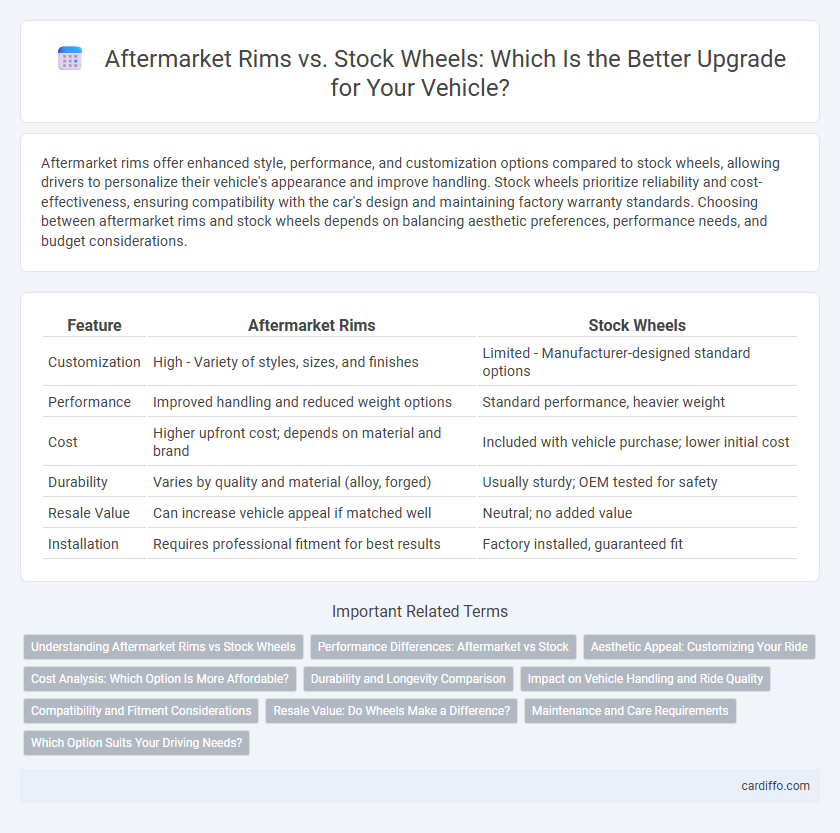Aftermarket rims offer enhanced style, performance, and customization options compared to stock wheels, allowing drivers to personalize their vehicle's appearance and improve handling. Stock wheels prioritize reliability and cost-effectiveness, ensuring compatibility with the car's design and maintaining factory warranty standards. Choosing between aftermarket rims and stock wheels depends on balancing aesthetic preferences, performance needs, and budget considerations.
Table of Comparison
| Feature | Aftermarket Rims | Stock Wheels |
|---|---|---|
| Customization | High - Variety of styles, sizes, and finishes | Limited - Manufacturer-designed standard options |
| Performance | Improved handling and reduced weight options | Standard performance, heavier weight |
| Cost | Higher upfront cost; depends on material and brand | Included with vehicle purchase; lower initial cost |
| Durability | Varies by quality and material (alloy, forged) | Usually sturdy; OEM tested for safety |
| Resale Value | Can increase vehicle appeal if matched well | Neutral; no added value |
| Installation | Requires professional fitment for best results | Factory installed, guaranteed fit |
Understanding Aftermarket Rims vs Stock Wheels
Aftermarket rims offer a broader range of designs, materials, and sizes compared to stock wheels, allowing for enhanced customization and performance tailored to specific driving needs. Stock wheels are engineered by the vehicle manufacturer to meet safety standards, durability, and cost efficiency but may lack the unique style or performance benefits of aftermarket options. Understanding the differences in weight, fitment, and material composition between aftermarket rims and stock wheels is essential for making an informed upgrade choice that balances aesthetics, handling, and safety.
Performance Differences: Aftermarket vs Stock
Aftermarket rims typically offer superior performance by being lighter and stronger than stock wheels, reducing unsprung weight and improving vehicle handling, acceleration, and braking. Stock wheels are designed for general use and durability but often sacrifice optimal weight and stiffness for cost and manufacturing efficiency. Performance gains from aftermarket rims include enhanced cornering stability and better heat dissipation, contributing to overall driving dynamics and safety.
Aesthetic Appeal: Customizing Your Ride
Aftermarket rims offer a wide range of designs, finishes, and sizes that enhance the visual appeal of your vehicle far beyond the standard look of stock wheels. Custom rims allow you to personalize your ride with unique styles--from sleek alloys to bold colors--creating a distinctive, eye-catching appearance. Upgrading to aftermarket wheels not only improves aesthetics but also reflects your individual taste and elevates the overall image of your car.
Cost Analysis: Which Option Is More Affordable?
Aftermarket rims typically offer a broader price range, with entry-level options starting as low as $100 per wheel, while stock wheels from manufacturers can cost between $300 to $600 each. Installation and customization expenses may elevate total costs for aftermarket upgrades, but they often provide better value and style diversity compared to the fixed designs of stock wheels. Considering long-term durability and resale value, stock wheels maintain consistent pricing, whereas aftermarket rims can vary significantly in affordability depending on brand and materials used.
Durability and Longevity Comparison
Aftermarket rims often provide enhanced durability due to superior materials like forged aluminum or alloy blends, promoting resistance to impacts and corrosion compared to standard stock wheels made from basic cast metals. Longevity is further extended in aftermarket rims through advanced coatings and finishes that protect against environmental wear, while stock wheels may deteriorate faster under harsh conditions. Vehicle owners seeking prolonged performance and structural integrity typically benefit from upgrading to quality aftermarket rims over factory-installed stock wheels.
Impact on Vehicle Handling and Ride Quality
Aftermarket rims often enhance vehicle handling by reducing unsprung weight and allowing for wider tires, which improve grip and cornering stability. Stock wheels are designed to balance ride comfort and durability, resulting in a smoother ride but less aggressive handling performance. Choosing the right wheel upgrade involves weighing the improved responsiveness of aftermarket rims against the comfort and reliability of original equipment manufacturer (OEM) stock wheels.
Compatibility and Fitment Considerations
Aftermarket rims offer a wider range of styles and sizes but require precise measurements of bolt pattern, offset, and center bore to ensure compatibility with your vehicle. Stock wheels guarantee exact fitment as they are designed by the manufacturer specifically for your make and model, reducing risks of clearance issues and tire wear. Proper fitment is crucial to maintain vehicle safety, handling, and performance when upgrading from stock wheels to aftermarket rims.
Resale Value: Do Wheels Make a Difference?
Aftermarket rims can significantly boost a vehicle's resale value by enhancing its aesthetic appeal and signaling personalized care, often attracting buyers willing to pay a premium. Stock wheels preserve the original manufacturer look, maintaining warranty integrity and appealing to purists who prioritize authenticity. Choosing between aftermarket rims and stock wheels affects market perception and depreciation rates, making wheels a critical factor in used car valuation.
Maintenance and Care Requirements
Aftermarket rims often require specialized cleaning products and more frequent inspections to prevent damage from road hazards, whereas stock wheels typically have durable finishes designed for minimal upkeep. Maintenance routines for aftermarket rims must address potential issues like corrosion and scratches, necessitating protective coatings or sealants. Stock wheels generally offer easier maintenance with standardized replacement parts and coatings optimized for long-term resistance to environmental wear.
Which Option Suits Your Driving Needs?
Aftermarket rims offer customizable designs, enhanced performance, and improved handling tailored to specific driving styles, making them ideal for enthusiasts seeking personalized aesthetics and functionality. Stock wheels provide reliable durability, manufacturer-tested safety, and cost-effective maintenance suitable for everyday commuting and standard driving conditions. Evaluating your driving preferences, road conditions, and budget helps determine whether aftermarket rims or stock wheels best suit your automotive needs.
Aftermarket Rims vs Stock Wheels Infographic

 cardiffo.com
cardiffo.com